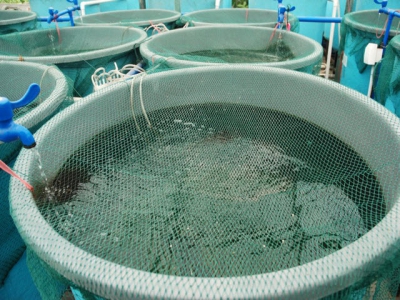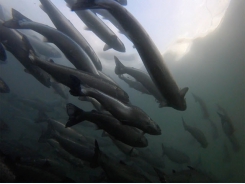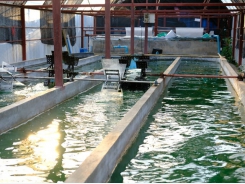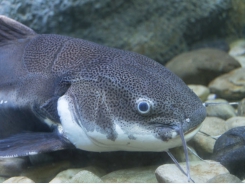Probiotic gives growth, immune response in farmed carp

Supplementing carp diets with B. subtilis may improve fish growth performance and support fish health and intestinal antioxidant capacity while reducing reliance on antibiotics, say researchers.
An international team of researchers from Nanchang University in China, the University of Idaho in the US and the Hagerman Fish Culture Experiment Station also in the US explored the use of prebiotics and probiotics including β-glucan and Bacillus subtilis in the diet of farmed Pengze crucian carp.
“The objective of the present study was to examine the effects of β-glucan and B. subtilis supplementation on growth performance, fillet quality, immune capacity, and antioxidant status of Pengze crucian carp,” the researchers said.
Following a 70-day feeding period, the researchers found that adding B. subtilis to fish diets boosted growth performance compared to fish on other diets.
Muscle texture results for springiness, hardness, cohesiveness, gumminess, chewiness and resilience were increased for fish receiving either supplemented diet than for control group fish.
Fish on the supplemented diets had improved fold height and microvillus height, lower total cholesterol, high-density lipoprotein and low-density lipoprotein along with heightened immune responses, they said.
Both supplements also increased the activity of digestive enzymes.
“Dietary supplementation with B. subtilis significantly promoted the growth performance of Pengze crucian carp, whereas β-glucan supplementation showed no positive effects; two additives significantly affected muscle quality of fish,” the researchers added. “Both β-glucan and B. subtilis supplementation could improve the fish health status by elevating immune responses and antioxidant capacity of intestine and system immunity measured by serum parameters of Pengze crucian carp.”
Why add prebiotics, probiotics to carp feed?
It has been common practice to use a range of chemicals in aquaculture production including disinfectants, antibiotics and anthelmintic agents, the researchers said.
Globally, antibiotics are often used to address bacterial diseases, which has a risk of prompting microbial dysbiosis, the generation of antibiotic-resistance pathogenic bacteria and the accumulation of antibiotics in aquaculture products.
There is increasing interest in aquaculture production without relying on the use of antibiotics, they said.
Prebiotics and probiotics are of interest as an alternative for aquaculture producers as they have been linked to improved health and a reduction in diseases.
Fish fillet quality also is a consideration on the commercial side and is related to diet, they said. Little is known about the influence of prebiotics or probiotics on fish fillet quality as most of the focus has been on their support of growth or immunity.
β-glucan are a common prebiotic found in the cell walls of plants, bacteria and fungi, the researchers said. Those used in aquaculture are often derived from yeast and act as immunostimulants.
Past research with several aquaculture species found that the prebiotic can promote “phagocytic, cytotoxic and antimicrobial activities,” increase antioxidant capacity, lower production of reactive oxygen species (ROS) and improve the immune capacity, they said.
It also is thought that the feed additive may support growth performance in some fish species.
Probiotic are microorganisms that can support the homeostasis of intestinal microbiota by altering a fish’s microbial community, they said.
The supplements also have been linked to a benefit in health through organ maturation, nutrient metabolism and immunity.
However, there has been no work examining the use of β-glucan or B. subtilis in the diets of Pengze crucian carp, the researchers said.
Pengze carp is an omnivorous, freshwater fish widely raised in China and with economic importance for producers, they said.
“In recent years, diseases occurred more frequently in Pengze crucian carp farming due to the development of intensive aquaculture and deterioration of water quality,” they said. “Numerous studies have demonstrated the biological effects of β-glucan and B. subtilis on fish, whereas little is known in Pengze crucian carp.”
Feeding trial details
In the feed additive use trial, juvenile fish received one of three diets for a 70-day period, the researchers said.
The diets included fishmeal, soybean meal, cottonseed meal and rapeseed meal as protein sources, fish oil and soybean oil as lipid sources along with wheat gluten meal and wheat flour to provide a carbohydrate source.
The diets examined included a control, and that diet supplemented with 1g kg-1 β-glucan (BG group) and the control diet with 1 × 10 9 CFU kg-1 Bacillus subtilis (BS group), they said.
The yeast-based β-glucan was commercially available and all diets were pelleted with a 3mm sieve.
Fish were acclimated to trial conditions for three weeks while receiving the basal diet, they said.
Fish were weighed at the start and end of the feeding period, the researchers said. Select fish on each diet were harvested, weighed, measured, blood samples were collected and the hepatosomatic index (HSI), viserosomatic index (VSI) and condition factor were determined.
Additional fish were collected for blood samples along with whole liver and midgut samples to assess enzyme activities, they said. Select fish were checked for proximate composition and others were assessed for fillet quality.
Results
At the end of the trial period, fish on the supplemented diets weighed more and had a higher specific growth rate and HSI, the researchers said. Fish on the BG diet had the highest VSI, while those on the BS diet had the lowest.
However, crude protein, lipid and ash for the whole fish was not altered nor was condition factor, they said.
“Overall, the results indicated that B. subtilis improved the growth performance by increasing the digestive enzymes activities and improving the intestinal morphology,” they added. “β-glucan and B. subtilis supplementation significantly improved the fillet quality, immune responses and antioxidant status of Pengze crucian carp.”
Use of the feed additives also altered the texture of the fillet, they said.
Serum lactate dehydrogenase (LDH) activity was reduced for fish on the BG diet, the BS fish had the highest glucose (GLU) content, but fish on both supplemented diets had lower blood urea nitrogen (BUN) and ammonia, the researchers said.
“The BG and BS groups have higher ACP [acid phosphate] activity, and the difference was significant between BG and Control group,” they said. “Dietary supplementation of β-glucan and B. subtilis exhibited significantly higher AKP [alkaline phosphatase] and CAT [catalase] activities than Control group.”
Fish on the control diet had the highest hepatic glycogen in liver tissue, they said. Adding, “The digestive enzymes and immunity of mid-intestine were clearly affected by supplementation with β-glucan and B. subtilis.”
Fish on the BG diet had the highest amylase, acid phosphatase and alkaline phosphatase activity, while those on the BS diet had increased lipase and tryptase, they said. Fish on both supplemented diets had higher levels of glutathione peroxidase, reduced glutathione, fold height of the mid-intestine, microvillus height and Total-superoxide dismutase. but lower MDA content.
Source: Aquaculture
Authors: H. Cao, R. Yu, Y. Zhang, B. Hu, S. Jian, C. Wen, K. Kajbaf, V. Kumar, G. Yang
Related news
Tools

Phối trộn thức ăn chăn nuôi

Pha dung dịch thủy canh

Định mức cho tôm ăn

Phối trộn phân bón NPK

Xác định tỷ lệ tôm sống

Chuyển đổi đơn vị phân bón

Xác định công suất sục khí

Chuyển đổi đơn vị tôm

Tính diện tích nhà kính

Tính thể tích ao




 Zinc, omega-3 fatty acids influence salmon health
Zinc, omega-3 fatty acids influence salmon health  Could catfish oust tilapia as Ghana’s favourite farmed…
Could catfish oust tilapia as Ghana’s favourite farmed…